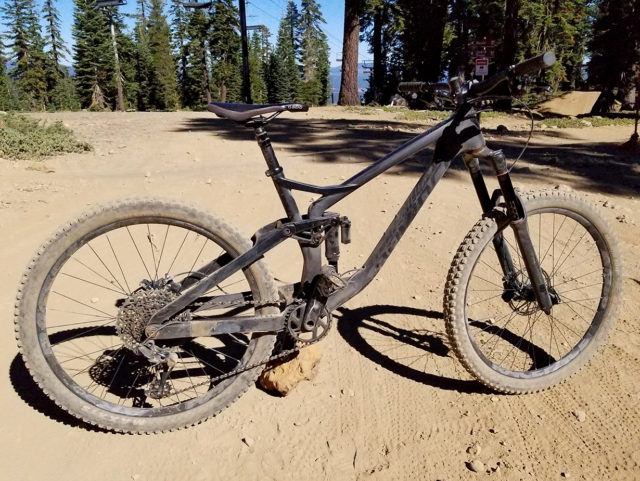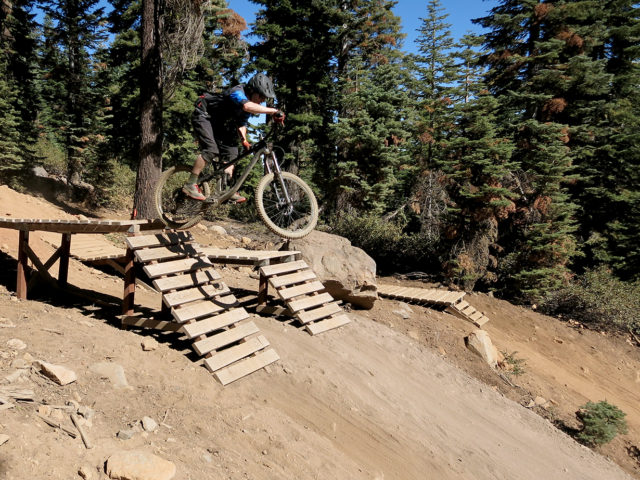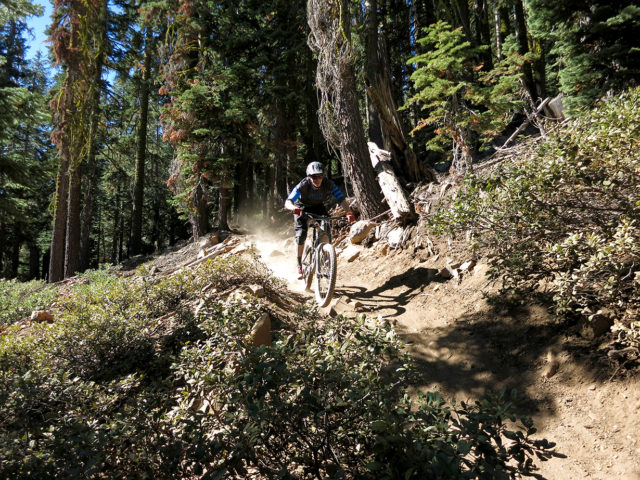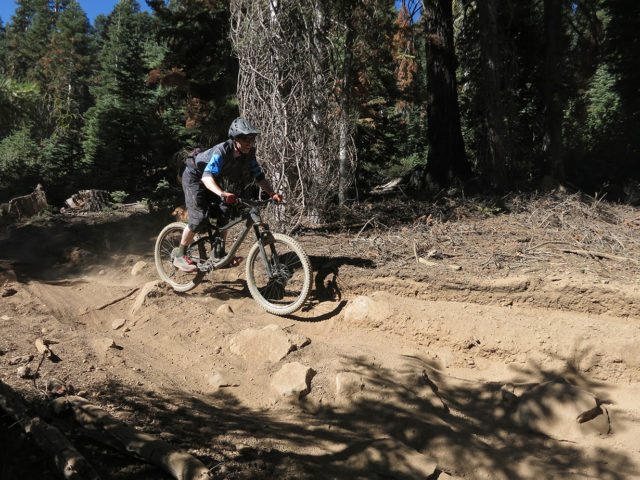Devinci Spartan Carbon 27 GX 12S
Size Tested: Large
Geometry: (Here)
Build Overview:
- Drivetrain: Sram GX Eagle
- Brakes: Sram Guide R
- Fork: Rockshox Lyrik RC
- Rear Shock: Rockshox Super Deluxe RC3
- Wheels: Raceface ARC 30 / Formula
Wheels: 27.5′′
Travel: 165 mm rear / 170 mm front
Blister’s Measured Weight: 30.5 lbs (13.8 kg) without pedals
Reviewer: 5’9”, 155 lbs
MSRP: $5,199
Review Navigation: Specs // Full Review
Caveat
We rode this bike at Interbike’s outdoor demo, which moved locations this year and was held at the Northstar bike park in Tahoe. Northstar has some awesome trails, ranging from super rocky, technical trails that were covered in moondust to flowy jump trails that were also covered in moondust.
Normally, Blister tries to get as much time on a bike as we realistically can so that we have time to play around with setup, get comfortable with the fit, and hopefully reveal any durability issues that might arise. But for obvious reasons, spending an hour or two on a bike at Interbike’s outdoor demo doesn’t give us the time to give the bike our usual treatment, especially since we were mostly riding lift-served terrain that was (1) short on climbing, and (2) biased heavily towards the kind of trails you find in a bike park.
That said, there’s a lot of value in riding a bunch of different bikes, back to back on the same trails. Traits that might not be obvious when the bikes are ridden weeks or months apart become evident.
So in other words, back to back comparisons on great trails are useful, but don’t take this as the final word on these bikes, especially when it comes to maintenance and durability issues.
So with all that in mind, let’s take a look at the Devinci Spartan.
Intro
The revised Spartan 27.5 was released for 2018, and remains largely unchanged for 2019. The big news for the 2019 lineup is the introduction of the Spartan 29, which, aside from the wheel size, is pretty similar in terms of build kits and geometry to the Spartan 27.5.
When I got on the Spartan 27.5 at Interbike, the Spartan 29 hadn’t officially been released yet. And while the Devinci guys had a Spartan 29 in the stable, they wouldn’t let us ride it because we’re media people and we’re bad at keeping secrets (that weren’t really all that secret, but I digress). So for this review, I’m talking about the 2019 Spartan 27.5.
For the most part, I’ve been a fan of Devinci’s bikes — they’re not the lightest out there, but they’re backed by a lifetime warranty. And they’re not the most progressive bikes in terms of geometry, but they’re comfortably modern in their fit and angles. More than anything, for any given genre of bike, I think the Devincis are just really good examples of the middle ground of a descending-oriented bike. I’ll talk more about what that means below, but the question I had for this review was: does that describe the new Spartan? Does the Spartan stray from Devinci’s formula?
The Build
The Spartan comes in both aluminum and carbon frames, with a couple different builds for each frame. I rode the Carbon GX 12S, which has a carbon frame built around a Sram GX Eagle group. For a bit more money, Devinci also offers the GX 12S LTD build, which is similar to the one I rode except with a longer-travel fork (180 mm on the LTD vs. 170 mm on the “regular” version), and some upgrades to the brakes and cockpit componentry.
As the name implies, the GX 12S runs on GX Eagle shifty bits. I’ve spent a ton of time on the GX Eagle drivetrains, and it’s my pick for any bike I’m going to own — at least for me, it hits the right intersection of cost, weight, and functionality.
Suspension on the Spartan is handled by Rockshox front and rear, with a 170 mm Lyrik RC up front and a Super Deluxe RC3 in back producing 165 mm travel. As I’ve said, I think the Lyrik is a ridiculously good fork, although it’s worth noting that the LTD build bumps up to the more-awesomer Lyrik RC2. As for the Super Deluxe — it’s great, and it’s what I’ve been running on my Trek Slash (which has a pretty similar suspension design to the Spartan). The Super Deluxe isn’t quite as supple or as adjustable as the Fox Float X2, but the Super Deluxe still gets along quite well.
Wheels on the GX 12S build are Race Face ARC30 rims laced to Formula hubs. On the upside, that’s a decently stiff wheelset, and I’m of the opinion that the rim width is perfect for a bike like this because it works well with any tire width that you’ll realistically run on this bike. The downside is that the ARC30 rims are a bit on the soft side and dent a little easier than other options, and past experience has me a little nervous about the long-term durability of the Formula freehub body. That said, these wheels are as good if not better than those on most other bikes at this price point, so I wouldn’t use those quibbles as a reason to shy away from the bike.
Rounding out the build are Sram Guide R brakes (I like them, but I like the RSC’s a lot better), a Rockshox Reverb dropper post (not known for being infinitely bomber, but for the most part, it works well), and assorted cockpit bits from Race Face and SDG, all of which are fine and would only warrant swapping if you have strong personal preferences.
Fit and Geometry
As with the old Spartan (and a bunch of other bikes on the market these days), the 2019 Spartan has two geometry positions: Hi and Lo. I rode the bike in the Lo position, and for the sake of this discussion, I’m just going to talk about the numbers in that Lo setting. But keep in mind that the Spartan can be made a bit steeper and taller via a quick adjustment of the flip chips on the rocker link.
Fit on the new Spartan is modern without going overboard. Reach on the size Large that I rode is 465 mm, which is maybe slightly on the long side of average these days. The seat angle comes in at 74.5°, which would have been decently steep a couple of years ago, but by modern standards is somewhere between average and slack. But the Spartan’s horizontal top tube measurement still comes in at a fairly normal 628 mm on the Large, so again, the Spartan isn’t showing any fit numbers that are way outside of the realms of “normal.”
Similarly, the Spartan’s angles and lengths make for a bike that is definitely slack, but not pushing any boundaries of modern geometry. A 65° head angle is pretty standard for a bike in this travel class, and 430 mm chainstays are also pretty normal for a 27.5” wheeled bike. Those average-ish angles, combined with the average-ish reach yield an average-ish wheelbase of 1224 mm for the size Large.
The one standout number on the Spartan’s geometry chart is the bottom bracket height — at 337 mm, it’s fairly low for a bike with this much travel. The downside is that you have to watch for pedal strikes, but the upside is that the bike feels extra planted in corners.
Attentive readers will have picked up on the idea that the Spartan is pretty middle of the road in terms of geometry and fit. But I don’t want that to come off as a bad thing — if you’re looking for a bike that’s really pushing the boundaries of how a bike should fit, the Spartan isn’t it. But for most people who are looking for something that they can hop on and quickly feel pretty comfortable with, the Spartan is that.
And if none of these numbers make a lot of sense to you, or maybe if you just need a quick refresher on mountain-bike fit and geometry, check out our Geometry & Fit 101 and 201 articles.
The Ride
I said at the outset that Devinci tends to make bikes that fall into the middle ground of descending-oriented bikes. So what exactly does that mean?
For starters, I’m calling any longer-travel bike “descending oriented.” That means that, while it still needs to pedal to the top of the climb, it’s really built around having fun on the way down. I put pretty much any bike with 140 mm travel or more into that category, so for Devinci, that means the Troy and the Spartan.
And so what does the middle ground look like? It’s the bike that, looking at all of the options on the market, strikes the middle balance between uphill-friendly attributes and downhill-friendly attributes. Note that I didn’t say the “best” balance — the middle is the middle. The best depends on any given rider’s personal preferences.
So for a 165 mm bike like the Spartan, I’m comparing it to other 160-ish mm bikes, which means they’re pretty much all geared heavily towards going downhill fast. But that being said, some bikes within that class pedal better, climb better, weigh less, etc., while others are slacker, heavier, more supple over bumps, and generally crush the downhills just a bit more.
So does the Spartan follow Devinci’s formula and land pretty well in the middle of that spectrum? Yup, it sure does.
There are bikes in this travel class that pedal better, and are a bit quicker on the climbs (the Ibis Mojo HD4 comes to mind as a bike that’s just a bit quicker on the pedals). And there are bikes that just feel bigger, burlier, and more willing to plow through everything on the descents (the Pivot Firebird would be one example).
But the Spartan balances all of that to land pretty close to the middle.
On the climbs, the Spartan feels impressively efficient. Yes, there’s some pedal bob and yes, on longer, smoother climbs I’d probably use the climb switch on the rear shock. But all things considered, when you stomp on the pedals, the Spartan gets up and goes pretty decently. The only thing I’m left wishing for here is a slightly steeper seat tube angle.
But the Spartan is clearly built with descending in mind, and unsurprisingly, it gets along quite well. It’s slack enough to feel decently stable at speed, but I was actually surprised by how maneuverable it felt in tighter spots. Bigger, slacker bikes like this can often feel a bit piggish in slower-speed technical terrain, and riding the Spartan at Northstar meant that I got into plenty of rocky minefields on trails I hadn’t ridden before, where I didn’t know the lines. So when I inevitably picked a terrible line, the Spartan did better than most bikes I’ve ridden in this class in terms of re-directing the bike onto some semblance of a worthwhile line choice.
The Spartan also continues a trend that I’ve noticed in other Devinci bikes — it has a really straightforward, user-friendly leverage ratio on its rear suspension. That means that (1) the bike is progressive enough to not bottom out easily, even on relatively hard hits; (2) the bike isn’t so overly progressive that lighter or less aggressive riders will have trouble using all of the travel; and perhaps most importantly (3) the bike isn’t super picky about suspension setup, and it works pretty well with sag set in a variety of positions (I’ve found that anything from 25% to 35% works decently).
Really, the only noteworthy gripe I have from my time on the Spartan is the cables. They rattle inside the downtube, and it’s insanely annoying. A friend that owns one of these bikes jammed a bunch of moto-foam in there to keep everything quiet, and that works well.
Bottom Line
I owned the prior iteration of the Spartan, and I liked it. It did everything well, and I didn’t mind pedaling it on longer rides because, as far as 165mm-travel bikes go, it pedaled pretty well. But as modern bikes got longer and slacker, I adapted to the new trends in geometry and the old Spartan felt short and a bit steep. My (somewhat shorter than me) wife then spent a couple years on it, and then we eventually sold it.
The new Spartan is very much the modernized version of the old Spartan. Its suspension feels pretty similar, but the geometry is longer, lower, and slacker. And personally, I’m a fan. I liked the old version, and I think all of the updates to the new version make a lot of sense.
Among 160-ish mm travel bikes, the Spartan is the middle of the spectrum. It does everything pretty well. And for that reason, it’s a really easy bike to recommend, because it’ll work pretty well for everyone. For people that are 100% sure that they want something that climbs super efficiently, or that is the plowiest descender on the market, there are better bikes that are more singular in their focus. But for someone who wants a long-travel bike that still kills it on the descents but can also climb ok (by longer-travel bike standards), the Spartan is an excellent choice.




